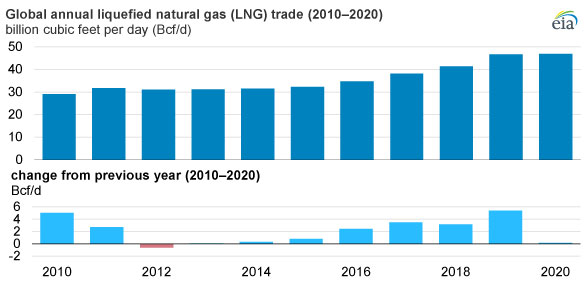Global trade in LNG in 2020 remained essentially unchanged from 2019, averaging 46.9 billion ft3/d compared with 46.7 billion ft/d in 2019, according to the recently released The LNG Industry: GIIGNL Annual Report 2021 by the International Group of Liquefied Natural Gas Importers (GIIGNL). This 0.4% annual increase in LNG trade occurred despite the COVID-19 pandemic that reduced global natural gas demand. Between 2015 and 2019, global LNG trade expanded by 45%, posting record growth in both 2018 and 2019. This expansion primarily resulted from liquefaction capacity additions in Australia, the US, and Russia, which combined accounted for more than 90% of the global growth in liquefaction capacity during this period.

Graph by the U.S. Energy Information Administration, based on data from the International Group of Liquefied Natural Gas Importers (GIIGNL), The LNG Industry, annual reports (2010–2021).
According to the EIA, in 2020, LNG exports increased from only two countries – the US by 1.5 billion ft3/d and Australia by 0.3 billion ft3/d – compared with 2019. Last year, the US commissioned several new liquefaction units (called trains), namely the third and final trains at Cameron LNG, Freeport LNG, and Corpus Christi LNG export facilities as well as the remaining trains at the Elba Island LNG export facility. With the spread of the COVID-19 pandemic and lockdowns in many LNG-consuming countries, US LNG exports significantly declined in June and July of 2020, but they have gradually increased in the months that followed and set consecutive all-time highs in November and December 2020.
In 2020, Australia became the world’s largest LNG exporter for the first time, overtaking Qatar, with exports averaging 10.2 billion ft3/d, an increase of 0.3 billion ft3/d (3%) compared with 2019. Exports from Qatar declined by 0.1 billion ft3/d (1%) compared with 2019. Exports from all other countries have either remained flat or declined, amounting to a combined 1.6 billion ft3/d decrease compared with 2019.
Among all LNG-importing regions, only Asia had an increase in annual LNG imports, by 1.1 billion ft3/d (3%), in 2020 compared with 2019. China and India drove the overall annual increase. China's LNG imports increased by 1.0 billion ft3/d and India by 0.4 billion ft3/d in 2020. In China, continuous growth in LNG imports mainly resulted from government-supported coal-to-natural gas switching policies to reduce air pollution. In India, all-time low spot LNG prices in the spring and summer of 2020 led to more fuel switching and an increase in LNG imports procured on a spot basis. LNG imports to Japan continued to decline in 2020, averaging 9.8 billion ft3/d, which was 0.3 billion ft3/d less than in 2019. Europe’s LNG imports declined by 5%, averaging 10.7 billion ft3/d in 2020, but remained significantly higher than the 6.1 billion ft3/d in 2017 and 6.4 billion ft3/d in 2018, the EIA states.